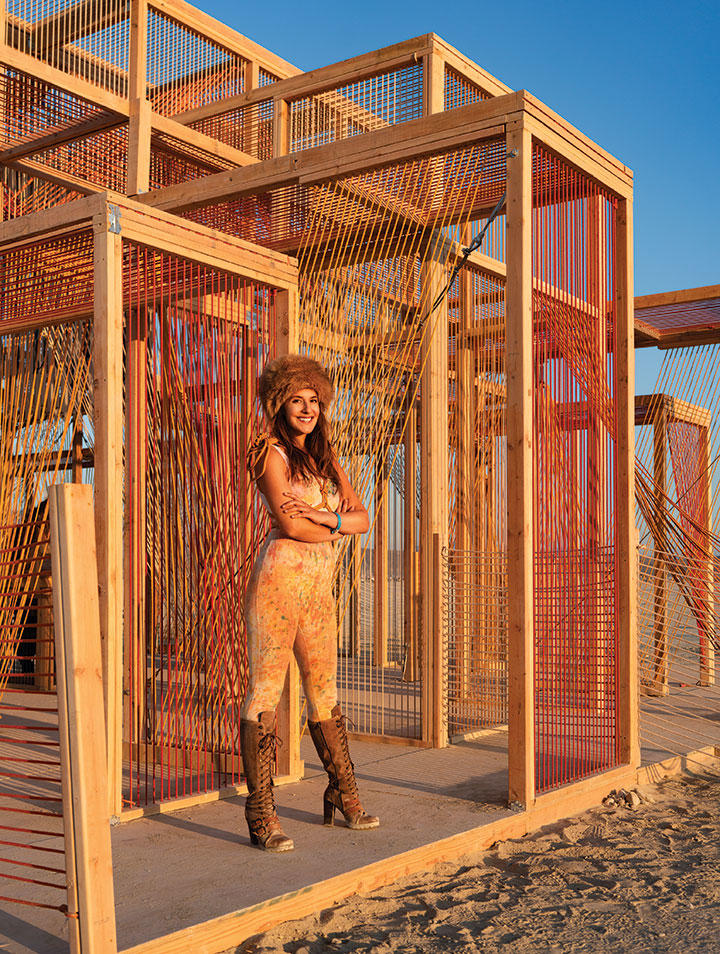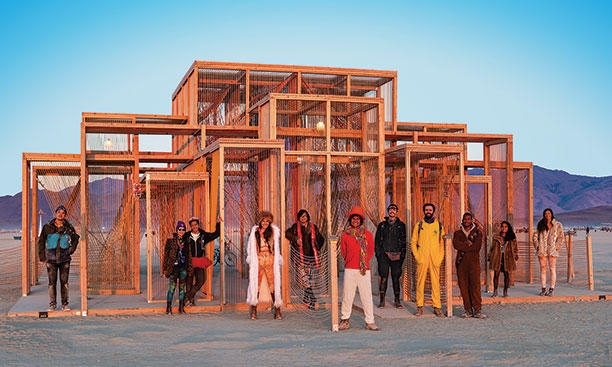Architect Kate Greenberg ’10 Brings Her Art to Burning Man
Kate Greenberg ’10 first attended Burning Man in 2015 just to see what all the hype was all about. She became instantly captivated with the event, which constructs a temporary city in a Nevada desert for around 70,000 people each year for one week of art-infused communal living. Greenberg, an architecture associate, was so taken with the experience she left determined to only return to “the Playa” (Burning Man nomenclature for the expanse of desert they inhabit) as a contributing artist. Though many of hundreds of the large- and small-scale art works on display each year are crowdfunded or independently financed, Greenberg has twice been granted an official Black Rock City Honoraria for her work by the Burning Man Arts organization — an honor reserved for only 60 to 70 pieces. Greenberg spoke to PAW about her journeys in the desert.
Feeling the Burn “It didn’t take long after moving to the Bay Area for me to hear about Burning Man. The stories and images were too much to resist, and I had to scope it out myself. So, in 2015, I spent nearly all of my recreational savings on a ticket, faux-fur jackets, and protein bars; built a palatial hexayurt; and drove 350 miles towards dusty adventure with a friend, many gallons of water, and very few preconceptions.
“What I discovered there was overwhelmingly magical; an entire city that had blossomed in the middle of a wasteland through the participation of nearly 70,000 humans acting as one community. I was blown away by the immensity of Black Rock City [the name of the temporary civilization], and by how it seemed to arrive at a delightful fulcrum between productive organization and pure chaos. Design abounded: in the city’s urban plan, in hundreds of art installations, and other endless forms of self-expression.
“I felt immediately included, like I was being welcomed home, but also a felt guilt over what I might describe as creative freeloading. I was taking all of that experience in, readily consuming the inspiration that seems to be BRC’s natural byproduct, yet I’d done nothing to bring about the landscape of my temporary reality. So as I left, I decided that I wouldn’t return to Burning Man unless I did so as a true contributor. The following month I applied for a Burning Man Arts grant, brainwashed some of my close friends into helping me bring to life a fairly ludicrous installation, and showed up for the 2016 Burning Man with my first piece, Chronosydra, an 11-foot-tall hourglass that ran in reverse for the week. Starting empty and ending full, it reflected on the way Black Rock City can reset, refill, and rejuvenate us, if we let it.”
Tracing Trace “The sculpture was created from hand-dyed colored rope, with more than 150 prefabricated panels of wood frames strung with braided cotton rope. Trace’s rope panels were composed on top of a 40-foot-by-40-foot modular deck and reached 18 feet high. The project used more than 8 miles of rope, which the team hand-dyed.
“The intended effect of all of this rope, overlapping at different angles and in various colors, was for light and shadow to play dynamically within the installation. At night, an LED chandelier that hung at the center of the piece furthered these moiré effects and dramatically altered the light reflectance of various dye hues, creating the illusion that patterns, colors, and perspectives were actively modulating within the space. … It was fabulously hypnotic. Trace was inspired by the interconnectivity and ephemerality of the playa, and reflected on the way Burning Man teases our perception of reality as we generate and explore it together — like a shared dream. The sculpture was created from hand-dyed colored rope, in a form that celebrated how individual journeys cross paths on playa, yet intertwine to shape an evanescent landscape and its broader community.”
Art workers “An incredible team of people made this vision a reality. Trace had a core crew of about twenty volunteers, although nearly 40 total lent a hand throughout the process. After the design and structural engineering was finalized, our team worked prefabrication every weekend for nearly three and a half months before packing the project into a semi-trailer. When we arrived — eight days early — to the Nevada desert, we assembled the piece for the first and only time. By then, I had been working on Trace for nearly a year.
“The majority of the crew were novice builders and burners [aka Burning Man attendees]. Despite that, we fought 10-hour-long whiteouts in 50 mph winds with scaffolds and screw guns, and somehow came out the other end with an installation exactly to spec. I could not be prouder of how our entire team worked together; trust me when I say they kicked major ass.”
Burned out “Once completed, Trace only existed fully for five days. At sunset on the Thursday of Burning Man, we burned the whole thing to the ground. Tapping into the tradition and experience of burning art at Burning Man was a key design goal for this project from the beginning. This was a unique way to practice creative detachment, which has been a weakness of my design process in the past, but is ultimately one that becomes a necessary part of working with clients. Also, how often do you get to — legally — build something and then destroy it completely? It is a radical experience. Burning Trace meant that it was specifically designed for one location and one moment in time, after that moment passed it transitioned fully into the ephemeral and our efforts and experiences there were sealed in our memories that much more dearly.”












No responses yet